


Sea Surface Temperature Increase
Sea surface temperature has increased as the amount of heat absorbed by the oceans has surged in the past few decades, causing marine heat waves and contributing to more intense storms, sea level rise, sea ice melt, and widespread ecosystem change.
Read MoreMar 13, 2019
Bomb Cyclone March 2019
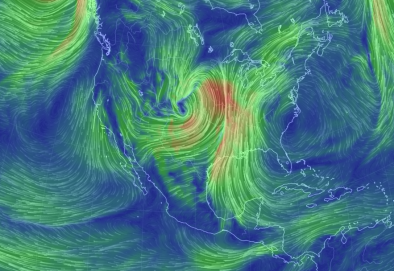
Feb 1, 2017
Global Heat Records 2017

Mar 14, 2016
Global Heat Records 2016

May 14, 2020 | CNBC
Tropical storm could form off the East Coast this weekend before hurricane season even begins
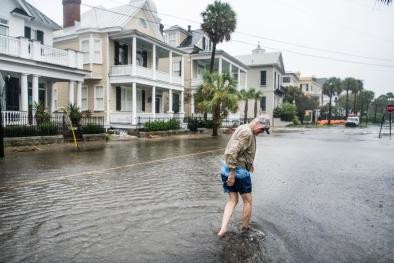
Mar 23, 2020 | The Guardian
Great Barrier Reef watchers anxiously await evidence of coral bleaching from aerial surveys

Feb 11, 2020 | CNN
Some Antarctic penguin colonies have declined by more than 75% over 50 years

Aug 21, 2017 | Naval Research Laboratory
Gulf of Mexico Hypoxia Watch
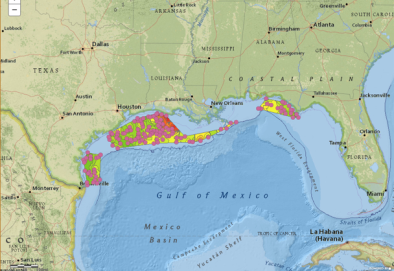
Mar 20, 2017 | NOAA/ NWS/ NCEP/ EMC Marine Modeling and Analysis Branch
Daily ENSO 1+2 Regional Sea Surface Temperature Anomaly
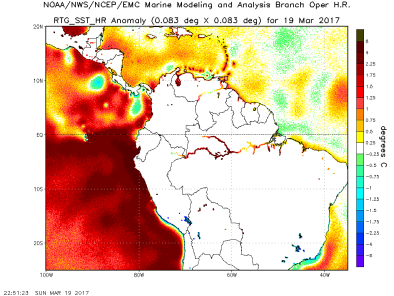
Dec 9, 2016 | Great Lakes Surface Environmental Analysis (GLSEA) | NOAA
Great Lakes Average Surface Water Temperature
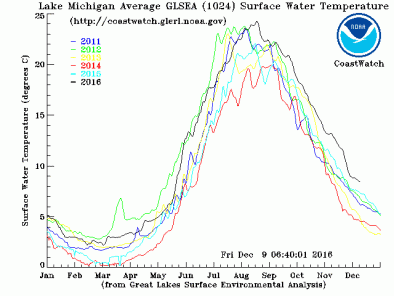
Feb 6, 2020 | Intergovernmental Panel on Climate Change
Special Report on the Ocean and Cryosphere in a Changing Climate
Jan 14, 2020 | Advances in Atmospheric Sciences
Record-Setting Ocean Warmth Continued in 2019
Dec 5, 2019 | Geophysical Research Letters
Evaluating the performance of past climate model projections
Climate science at a glance
- Sea surface temperature has steadily warmed over the long-term since the mid-19th century.
- The top ten hottest years in the ocean were the top ten years on record.[1]
- Each of the past four decades has been successively warmer at the Earth’s surface than any the previous decades in the instrumental record, and the decade of the 2010s was the warmest.
- Mean sea surface temperature has increased since the 1970s at a rate of 0.20°F (0.11°C) per decade.[2]
- Ocean expansion due to continuous ocean warming (along with land ice melt) is contributing to the accelerating rate of sea level rise.
- Warmer sea surfaces have more energy to convert to hurricane winds, which scientists say is likely increasing the intensity of the most hurricanes.
Background information
What is the significance of sea surface warming?
Oceans are the main place where extra heat due to human-caused warming is getting stored. Between 1971 and 2010, about 93 percent of the heat trapped by greenhouse gas emissions ended up in the ocean.[2] As a result, measuring ocean heat content (OHC) is one of the best ways to quantify the rate of global warming.[1] The majority of the extra heat stays close to the ocean surface, but more than a third has ended up in the deep ocean.
US sea surface temperature trends
- Annual average sea surface temperature has increased along all regional coastlines in recent decades, according the the Fourth US National Climate Assessment (NCA). The NCA compared the difference between the average for 1986–2016 (i.e., present-day) and the average for 1901–1960. Increases were largest in Alaska (greater than 1.0°F) while increases were smallest (less than 0.5°F) in coastal areas of the Southeast.[3]
- Increasing sea surface temperatures are contributing to overall declining oxygen concentrations at intermediate depths in various ocean locations and in many coastal areas.[3]
US attribution studies show warmer sea surface temperatures worsen weather extremes
- (Lim et al 2018): Unusually warm sea surface temperatures likely played a key role in the active 2017 Atlantic hurricane season.[4]
- (Rupp et al. 2017): Warmer sea surface temperatures due to climate change extreme precipitation deficits (like those in the Central US in summer 2012) 3 to 4 times more likely.[5]
- (Trenberth et al. 2015): Warmer sea surface temperatures due to climate change contributed to the sheer volume of moisture in the atmosphere for several storms including Hurricane Sandy, Snowmaggedon, and the Boulder floods.[6]
- (Trenberth et al. 2007): Analysis of the impact of climate change on Hurricanes Katrina and Ivan indicates that increased sea surface temperatures and water vapor related to human influences on climate since 1970 increased associated storm rainfalls by around 6 to 8 percent.[7]
Global sea surface temperature trends
- On a global scale, ocean warming is largest near the surface. Over the period 1971 to 2010, the upper 246 feet (75 meters) warmed by 0.20°F (0.11°C) per decade.[2] Across the four decades from 1971 to 2010, this sums to 0.8°F (0.44°C) of sea surface warming.
- An independent 2018 analysis finds that the ocean gained 1.33±×10^22 joules of heat per year between 1991 and 2016, equivalent to a planetary energy imbalance of 0.83 watts per square meter of Earth’s surface.[8] The results suggest that ocean warming is at the high end of previous estimate.
- Sea surface temperatures have risen by 0.5–0.6 °C since the 1950s, and over the oceans this has led to 4 percent more water vapor in the atmosphere since the 1970s.[9]
Global attribution studies show warmer sea surface temperatures worsen weather extremes
- (Knutson et al. 2019): Climate change and sea surface warming has led hurricanes in the Northwest Pacific to reach maximum intensity closer to the poles.[10]
- (Walsh et al. 2018): The 2016 Alaska marine heatwave was unprecedented, and could not have occurred without human-induced warming.[11]
- (Gillett et al. 2008; Santer et al 2006): Climate change is contributing to sea surface temperature increases in the Atlantic and Pacific regions where hurricanes form.[12][13]
Earth Systems Signals
Global warming is causing widespread and rapid changes in the atmosphere, ocean, cryosphere and biosphere.
Heat Signals
The Earth is getting hotter due to human activities that release heat-trapping gases into the atmosphere.
Drought Signals
Climate change is making droughts more likely to occur, and more severe when they do.
Wildfires Signals
Climate change is increasing the size, frequency, intensity and seasonality of wildfires.
Hurricanes Signals
Warmer temperatures increase the rate of water evaporation, which feeds moisture and energy into storms.
Floods Signals
Worsening floods due to climate change are putting a growing number of communities at risk.








